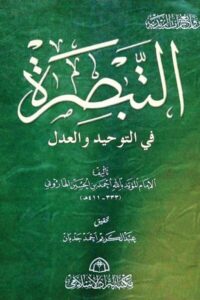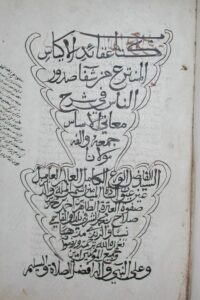Al-Muʾayyad bi-llāh’s theological treatise, al-Tabṣira
Al-Muʾayyad bi-llāh (he who is supported by God), Abū l-Ḥusayn Aḥmad b. al-Ḥusayn al-Hārūnī belonged to the Ḥasanī branch of Muḥammad’s descendants on his father’s side and to the Ḥusaynī branch on his mother’s side. He was born in 333/945 in al-Kulādhija, a village that belonged to his family in the vicinity of Āmul on the southern shores of the Caspian Sea. Although his father followed the Twelver branch of Shi‘ism, Al-Muʾayyad bi-llāh converted to the Zaydī conviction as a young man after he had studied law and Muʿtazilī theology according to the Baghdadi School. His younger brother al-Nāṭiq bi-l-Ḥaqq Yaḥyā (d. ca. 424/1032) followed his example. The two brothers studied first Zaydī law according to the schools of al-Qāsim al-Rassī and al-Hādī ilā l-Ḥaqq under the Zaydī scholar Abū l-ʿAbbās al-Ḥasanī (d. 353/964) in Āmul; they also studied Islamic tradition and law according to the legal school of al-Nāṣir lil-Ḥaqq. They studied theology in Baghdad by the reputed Muʿtazilī theologian from the Baṣran School Abū ‘Abdallāh al-Baṣrī (d. 369/980). At a later point in his career, al-Muʾayyad joined the court of the celebrated Buyid vizier and patron of scholars in Rayy al-Ṣāḥib b. ʿAbbād (326/938-385/995), where he was distinguished and treated favourably and where he had the chance to befriend the celebrated al-Qāḍī ʿAbd al-Jabbār as well as other great scholars.
In 380/990, al-Muʾayyad bi-llāh proclaimed his summons and took Hawsam by force from a certain Shirzīl, who was the governor there for the Buyid ruler Fakhr al-Dawla. Al-Muʾayyad bi-llāh’s rule lasted for a year before he was defeated by Shirzīl and imprisoned for several days. After his release from prison, he went back to Rayy where he stayed for several years. Around 387/997, possibly after the death of Fakhr al-Dawla, he engaged in a second attempt; he occupied Hawsam and its environs and ruled for two years from Langā the first capital of the Zaydīs and the city where al-Muʾayyad bi-llāh himself was nurtured and educated, yet his endeavours failed. He ruled for some twenty years under difficult political circumstances until he died on 10 Dhū l-Ḥijja 411/27 March 1021.
Al-Tabṣira
Al-Muʾayyad bi-llāh wrote a brief booklet (treatise) meant for instructing students in Zaydī-Muʿtazilī theology entitled al-Tabṣira (The Book of Instruction). It was designed as an introductory work for beginners. Other such theological manuals from that period were authored by Mu‘tazilī scholars.
Al-Muʾayyad bi-llāh’s is a brief treatise offering a summary of the main principles and theological loci that draw the basic contours of the Zaydī-Muʿtazilī theory. Al-Muʾayyad’s exposé is built around the five principles of the Zaydiyya:
- God’s unicity (al-tawḥīd).
- God’s justice (al-ʿadl) and human responsibility.
- Prophecy (al-nubuwwa).
- Eschatology, the promise and the threat (al-waʿd wa-l-waʿīd).
- The Imamate (leadership and guidance of the Muslim community) and commanding the right and prohibiting wrong¾the active social-political dimension.
The fourth item according to the Muʿtazila is that of “the intermediate position of the grave sinner,” but al-Qāsim al-Rassī didn’t count it among his principles (cf., Thiele, Theologie, 3-4). Al-Hādī ilā l-Ḥaqq considered it among the five principles, but at a later stage replaced it with that of the Imamate.

In this blogpost I will only address the points dealing with God’s unicity (al-tawḥīd) and God’s justice (al-ʿadl) and human responsibility.
Similar to the Muʿtazila, al-Muʾayyad commences with an emphasis on the importance of investigation (al-naẓar) and speculative reasoning incumbent on every adult Muslim (obligatee) in order to demonstrate the existence of God (Abdulsater, “Reason”), since knowing God is an act of divine help (luṭf) in the sense that this divine help is an aid to the human being to guide him in performing his duties and avoiding vile acts. His argumentation is very brief and it follows the rules of disputatio, “should one say ..., we would answer as such” (fa-in qīla .., qīla lahu). However, at times the argumentation is absent altogether; as in the case when answering the postulation “why is knowing God (maʿrifat Allāh) not a necessary act (ḍarūrī) that occurs by the very nature of human reasoning?” Al-Muʾayyad simply rejoins by saying, “Because this is already proved and, moreover, because servile imitation (taqlīd) is proven invalid.” Mānkdīm (d. 425/1034; author of [Taʿlīq] Sharḥ al-uṣūl al-khamsa. He was follower of al-Muʾayyad bi-llāh who led the funeral prayer at his burial in Lanjā) comments that he recalls that it was most probably, al-Muʾayyad bi-llāh, who said that some obligatees (mukallafūn) such as prophets, friends of God, and the righteous, are capable of a necessary knowledge of God.
It is noteworthy, however, that contrary to the current procedure by the Baṣran Muʿtazila, al-Muʾayyad does not always resort to rational proofs in order to substantiate his arguments but turns instead to proofs exclusively derived from the Quran (adilla samʿiyya). In fact, in this, al-Muʾayyad falls in line with the methodology of al-Qāsim al-Rassī and his grandson al-Hādī ilā l-Ḥaqq. According to the Zaydī Imam al-Qāsim b. Muḥammad (d. 1029/1619), drawing on samʿī-proofs in investigation (al-naẓar) is a valid method “since it kindles the hidden treasures of the mind,” as Aḥmad al-Sharafī (d. 1646, Zaydi theologian from North Yemen) comments. Subsequently, al-Muʾayyad differentiates between the nuances in Arabic language pertaining to the meaning of visual sight and mental insight since both are called (al-naẓar) and appear in the Quran in assorted shades of meanings.


In the second section, al-Muʾayyad moves to deal with the first principle of God’s unicity. Again, he employs proofs derived from the Quran (Q 1:164; 21:30; 23:12-14). In fact, the meaning and context of Q 23:12-14 is repeated in the Quran in various other verses, which were also employed as a proof for the knowledge of God by al-Qāsim al-Rassī.
Compelling, however, is al-Muʾayyad’s observation which equates the stages of creation in the womb enumerated in this Quranic verse with the “states” or modes (ḥāl, pl. aḥwāl) of Abū Hāshim al-Jubbāʾī (d. 321/933). The theory of the “states” is quite complicated, especially because it is meant to fathom the determinant (maʿnā) of the “conditions or states of being of the entity of which they are attributes” (Frank, Being and Attributes 19). According to Wisnovsky, “While the attributes understood as ma‘ānī really exist in the being that possesses them, the attributes understood as aḥwāl are neither existent nor non-existent, they enjoy an intermediate ontological status” (“Essence and Existence”). Frank explains that “the attributes and states, in that they are not true entities but rather attributes and characteristics of entities, cannot be said to exist” (Being and Attributes 26) since these states “do not ‘inhere’ in a subject, for this is the property of accidents (a‘rāḍ) alone.” What does al-Muʾayyad exactly mean by the “aḥwāl” in his survey?
The difficulty to reach a clear understanding arises from the fact that al-Muʾayyad bi-llāh’s description of the “states” as being, and at the same time, “in motion and yet at rest, adjacent (or in conjunction) and yet separated,” is actually a description of the accidents of space and location (al-akwān), and not of the modes (aḥwāl) that are regarded as determinants, non-entitative accidents; nonetheless, both concepts are commonly associated with each other. Most probably, al-Muʾayyad is referring to the fourth category of “states,” i.e., to those “attributes whose actuality depends upon the agent that effects the existence of the thing and, which, therefore, are said to be bi l-fā‘il”.
Al-Muʾayyad proceeds to prove God’s primary attributes, which are: being all-powerful and capable of autonomous action (qādir), being All-knowing or omniscient (ʿālim), being alive (ḥayy), being All-hearing and All-seeing (samīʿ and baṣīr), and being eternal (qadīm; for Mānkdīm ‘powerful’ comes first; see another Zaydī sequence of God’s essential attributes in al-Sharafī, Sharḥ i, 326-36). All proofs are constructed from evidences of phenomena (wajadnā fī l-shāhid) and are, moreover, common in Baṣran theological arguments. A salient point is that al-Muʾayyad employs here only rational argumentations, although he is very brief in his rationalization.
Given this reasoning, al-Muʾayyad categorically refutes that God could be similar to anything (shayʼ min al-ashyāʼ); if this were the case, He would have been originated. He proceeds by giving examples from the Quran to prove God’s transcendentality.
Based on similar proofs, he moves to rule out the possibility of His being ‘inherent’ in place/localities the same way that accidents inhere in substrates. It is noteworthy that Mānkdīm refers to al-Muʾayyad in his argument on this question, saying “The Sayyid, Imam had mentioned that this argument is not to be employed (laysa bi-muʿtamad)”. Nonetheless, such an opinion is not found in al-Muʾayyad’s Kitāb al-Ṭabṣira. It seems to me that there are three possible sources for Mānkdīm’s quotation; either he is referring to another book by al-Muʾayyad, or he is referring to a copy which did not reach us (perhaps Mānkdīm’s own annotated copy), or, conceivably, he is relying on a verbal utterance by al-Muʾayyad.
In arguing against the possibility of “seeing God” (ruʾya; ruʾyat Allāh) in this life or in the Hereafter (the beatific vision), al-Muʾayyad follows in his abbreviated discussion the Muʿtazilī argumentations, which in this specific case allow for proofs from revelation. By quoting Q 6:103 “Eyes reach Him not, He reaches the eyes,” al-Muʾayyad first establishes the impossibility of seeing God in this world. As a second step, he distinguishes in the meaning of vision (naẓar) in the Arabic language between the nuances of seeing, perception, and expectation (nāẓira). Finally, holding onto the linguistic point of view, he ascertains that ruʼya has the meaning of both knowing and perceiving, and not necessarily seeing with the pupil of the eye. A comparison between al-Muʾayyad’s section on the vision of God and the same subject by the other two sources, undoubtedly demonstrates the rather brief and diluted nature of his treatise; the other two sources deal in detail with the technical and physical aspects of vision (heat radiations emanating from a body, rays of light, and the complex function of the pupil), that remind of Ibn al-Haytham’s (d. 430/1039) innovative contribution in the field of human sight.
This leads al-Muʾayyad to close this part with a rational proof of the unicity of God, referring to the proof of the impossibility of the simultaneous existence of two eternal beings. He then adduces proofs from revelation, quoting Q 17:42 “had there been with Him other gods, as they allege, then they would have sought access to the Master of the throne.”
Given that the Zaydiyya, like the Muʿtazila, regard God’s speech as a secondary attribute of action, the discussion of this attribute is usually depicted under the second principle, that of God’s justice. Al-Muʾayyad, nonetheless, discusses the question of the Quran at the end of the section on God’s essential attributes, although he argues that it is created and generated, by delivering a proof from reason and another from revelation.
God’s Justice
Al-Muʾayyad now continues with the second major principle in his Zaydī-Muʿtazilī schemata, that of God’s justice (ʿadl). The whole question has to do with God’s will and command, i.e. with His intention in creating the universe. Consequently, the question takes a moral turn expressed by the theologians in terms of being morally good (ḥusn) or morally wrong (qubḥ), and of reward and punishment in relation to human actions.
Al-Muʾayyad’s reflections commence with an argument that God’s will and His command are the same, and that both are generated (Mānkdīm adds that God’s will is not inherent in any locality or substrate (bi-irāda muḥdatha lā fī maḥall), which is the common Baṣran view). Consequently, God cannot will contradictory commands; moreover, His commands to all those on whom His moral obligations are imposed (or those who are morally subject to the law), cannot be but good. What God actually wants from the obligatees, whether believers, unbelievers, or grave sinners (fāsiqūn) is that they obey Him and perform their duties and obligations; He does not will any evil. Al-Muʾayyad contends, after referring to proofs from revelation that God does not will evil because should He will it, this would necessitate that disobedient people be obedient, and this is inconceivable. Answering the determinists (mujbira). It is interesting to note that contrary to the majority of the Zaydiyya and the Muʿtazila, both al-Muʿayyad bi-llāh and the celebrated Muʿtazili theologian Abū l-Ḥusayn al-Baṣrī (d. 436/1044), do not consider the mujbira as unbelievers. Al-Muʿayyad bi-llāh retorts that if there existed something that the Eternal had not wished, this will not affect His ‘states’ (aḥwāluhu) in the sense that it does not allude to an impotence on the part of God. Having set, albeit very briefly, the premises of the discussion, al-Muʾayyad moves on to assert that God precludes all evil (mustaghnin ʿan jamīʿ al-qabāʾiḥ), knows that it is morally wrong, and is aware that He dispenses with it.
He then proceeds to furnish an argument to the theoretical question, readily cited by Muslim theologians, of whether God punishes the children of polytheists on the Day of Judgment, by explaining that He does not punish except those who have ‘a claim on’ punishment (man yastaḥiqq al-ʿiqāb), either by committing sins or by abandoning their duties, which is not the case of children, who do not merit punishment since they are not under moral obligation. There is nothing more infamous than inflicting pain on children. Should one, however, give the example of God inflicting pain on animals and children during their interval in life, al-Muʾayyad answers by calling on the traditional Muʿtazilī paradigm of divine compensation (ʿiwaḍ) bestowed upon them.
Answering the hypothetical question: What is the proof that the human being’s actions are not created by God (makhlūqa li)? Al-Muʾayyad espouses the frequent Muʿtazilī argument. The second level of rationalization according to the Baṣran School, is to prove human capability (istiṭāʿa), in the sense that God creates the ability by which the actions of human beings are performed. The question is whether this capability is created prior to the act or is synchronous to it. The question is definitely not as simple, as van Ess puts it “The theologians, however, were not interested in showing how action is generated within the network of human decision, but only in how God makes it possible.” (ThaS iv, 538),
Al-Muʾayyad’s basic argument, following the Baṣran school, runs as follows: should the capacity be synchronous to the action, this would entail that God has demanded obligations humans are incapable of fulfilling (taklīf mā lā yuṭāq), which is vile in itself and cannot be willed by God.
Bibliography
- Abdulsater, Hussein Ali, “Reason, Grace and the Freedom of Conscience: The Period of Investigation in Muʿtazilī Theology,” in Studia Islamica 110 (2015), 233-62.
- van Ess, Josef, ThaS = Theology and Society in the Second and Third Centuries of the Hijra: A History of Religious Thought in Early Islam, vol. 1, trans. John O’Kane; vols. 2-4, tr. Gwendolin Goldbloom, Leiden-Boston 2017-9.
- Frank, Richard M., Beings and their Attributes: The Teaching of the Basrian School of the Muʿtazila in the Classical Period, Albany 1978.
- al-Muʾyyad bi-llāh, Aḥmad b. al-Ḥusayn al-Hārūnī, al-Tabṣira fī l-tawḥīd wa-l-‘adl, ed. ʿAbd al-Karīm Aḥmad Jadabān, Ṣaʿda 1423/2002.
- al-Sharafī, Aḥmad b. Muḥammad b. Ṣalāḥ, Sharḥ al-asās al-kabīr: shifāʾ ṣudūr al-nās, ed. Aḥmad ʿAṭā Allāh ʿĀrif, 2 vols. , Ṣan‘āʾ 1411/1991.
- Thiele, Jan, Theologie in der jemenitischen Zaydiyya. Die naturphilosophischen Überlegungen des al-Ḥasan ar-Raṣṣāṣ, Leiden and Boston 2013.
- Wisnovsky, Robert, “Essence and Existence in the Eleventh- and Twelfth-Century Islamic East (Mašriq): A Sketch,” in Dag Nikolaus Hasse and Amos Bertolacci (eds.), The Arabic, Hebrew and Latin Reception of Avicenna’s Metaphysics, Berlin-Boston 2012, 27-50.
This blog entry is part of the Zaydi Studies Series commissioned and edited by Ekaterina (Kate) Pukhovaia, Leiden University.


